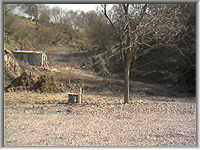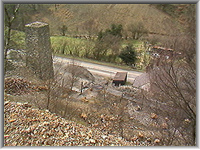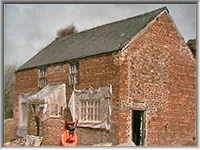East Roman Gravels Mine
Mining History Feature
East Roman Gravels Mine
Mining History Feature
Background
East Roman Gravels lead mine, also known as Wood mine, was owned by the Earl of Tankerville, it stretched for over a mile along the Hope Valley.
When the Hope brook carved out the valley it exposed many galena veins and in the eighteenth century, adits were driven into the hillside to exploit them. Shafts were also sunk, and this brick building probably housed a horizontal steam engine which wound materials from one of them.

This horizontal engine may have been the one that was described by a visitor in 1825 as "one of the most perfect little rotary engines".
When recorded in 1985 the engine house was being converted into a dwelling, thus saving it from demolition.
The nearby magnificent Cornish beam engine house was not so lucky and had been demolished a few weeks earlier. NGR SJ 3354 0017

Beside the road from Minsterley is the only other substantial remaining part of the mine - the truncated stone chimney of the ore crusher house. Of the crusher itself, only the foundations remain.
National Grid Reference: Wood Mine Engine House SJ 3356 0023,
Crusher House Chimney SJ 3352 0023
Other features:
Wood's Pumping Shaft & Engine house (site) SJ 3354 0017,
California Engine House (site) SO 3354 9996
Key Dates:
Early names for the mine: Wood Mine, Hope Valley Mine, Upper Batholes Mine, West Tankerville Mine.
c1700s: Group of mines in the Hope Valley known as the Batholes Sett - included East Roman Gravels and Batholes Mine.
c1770s: John Lawrence and partners lease the sett.
1790s: Wood Level drainage tunnel driven from the Hope Valley under the mine, good returns made.
1825: Visitor Mathew Francis describes the 24 inch cylinder, 4ft. stroke engine as "one of the most perfect little rotary engines that I have ever seen".
1830: Batholes Mine reported to be "empty"!
1831: John Lawrence reluctantly abandons the mine to pay his legal debts from fighting the Leigh Tunnel Company.
1847: Batholes Company Ltd. (a public company) lease the mine and concentrate work on the Wood Vein.
1853: Company sell off the Batholes Mine part of the sett to the newly promoted Hope Valley Company, due to poor returns.
1855, December: Batholes Company liquidated.
1855-66: East Roman Gravels worked in a small way by Frederick Jones (one of the original Batholes Company partners - he was also involved in coal mines at Pontesford and other local mines)
1870: West Tankerville Mining Company Ltd. (another public company) formed, leases the sett including Batholes Mines. The Mine Agent was Arthur Waters. Despite installing a new 30 inch engine and pumps, after a year of pumping the mine was found to be exhausted. So developed new ground at the Boundary with Roman Gravels.
1871: Batholes Mine sold off to a separate Company - Old Batholes Mining Company Ltd. (it failed and was bankrupt by 1874).
1872: New shaft sunk on South Boundary vein, (close to one sunk by neighbouring Roman Gravels Mine), the engine (NGR: SO 3354 9996) that pumped and wound from this shaft also pumped and wound from California and Cornish shafts - a technique unique in this area.
1874: West Tankerville Mining Company in trouble, raises £9,000 by issuing preference shares offering 15% dividends.
1882: West Tankerville Mining Company liquidated, but reconstituted as the East Roman Gravels Mining Company Ltd.
1883, February: The new company was £3,000 in debt, no good ore had been found and it was liquidated. The mines finally close.

